Samsung Galaxy Note II N7100 review
Not everybody knew just what to do with a device of which the size of the screen lies somewhere between a mobile phone and a tablet.
In spite of this, by now about 10 million of these devices have been sold, and this category has even gotten its own name: the phablet. A short while ago, the Samsung Galaxy Note II came out, and we had the chance to try this improved version.
We started our review period of the Galaxy Note Ii with an over-the-air firmware update. This is always very nice, since they often come with speed improvements or new functions. Moreover, the Note II already has a 5.5 inch screen, an 8 megapixel camera and a 1.6 GHz quadcore processor.
For the Note II it's hard to point out at the competition since it's such a remarkable device without many ‘natural enemies'. LG has the Optimus Vu in its range, just as the newer Vu II, but the both of them aren't available in the Netherlands. In the category of devices with a somewhat smaller screen, we can point at the Samsung Galaxy S3, HTC One X+ and the Nokia Lumia 920. Of course, we can't totally ignore the new iPhone 5.
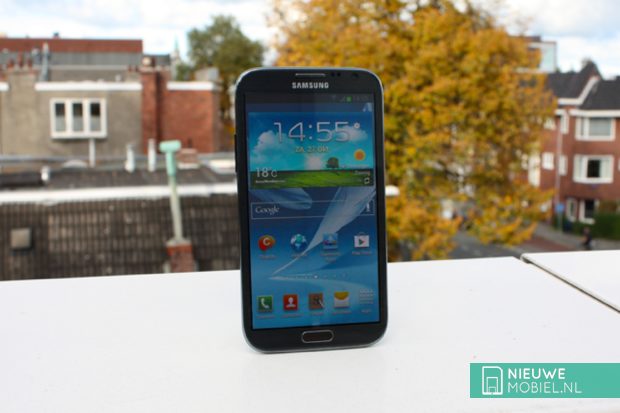
Unboxing
Even though mobile phones are getting larger and larger, the boxes still have to be as small as possible. Samsung did another good job in this. The Note II hardly fits into the box. Furthermore, they have managed to find space for an in-ear headset with sleeves in different sizes, a USB cable and an adapter to plug in the socket. All the accessories are white and look quite good. The USB cable is a bit shirt and the plug is a bit loose in the device. Although there is space for a micro SD card, this is not included in the package.
Appearance
Compared to its predecessor, the appearance of the Note II hasn't changed much, but due to the refinement of the details it looks a lot better. Moreover, it looks a lot like the ‘Nature'-inspired Galaxy S3. Since the screen is slightly bigger than that of its predecessor, but its proportions haven't been enlarged equally, there is less empty space left around the screen. This does mean that the touch sensitive buttons under the screen are even more close to the screen and that you'll touch them by accident more often.


Around the device, there is still a shining edge. The battery cover is no longer made out of dark grey matt plastic, but out of shiny plastic with a brushed aluminum look. This leads to a pretty close-fitting whole but it decreases your grip on the device. Apart from the two little notches for the camera and the flasher, the battery cover is smooth. It covers the entire back of the device.
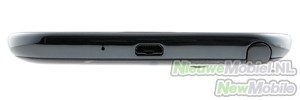
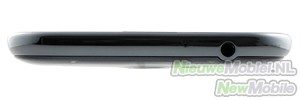
The downside of the device is used for the USB connection. Besides, also the S-pen or stylus disappears neatly into the device. On the left side are the volume buttons and opposite of these on the right side, we find the power button.
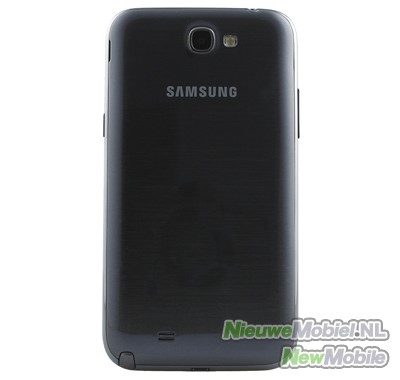

Even though the device is kind of heavy, it is less than a centimeter thick. That's why it doesn't have a very ponderous effect and the device remains manageable. Still, it won't fit in every pocket and it might slide out of it when you're sitting down.
Battery life
A screen as large as that of the Note II asks quite a lot from the battery and it has a undisputable effect on the battery life. Samsung must have realized that and since the screen has twice the size of a regular phone, they put in a battery that almost has twice the size of a normal one, too. It has a capacity of 3100 mAh.
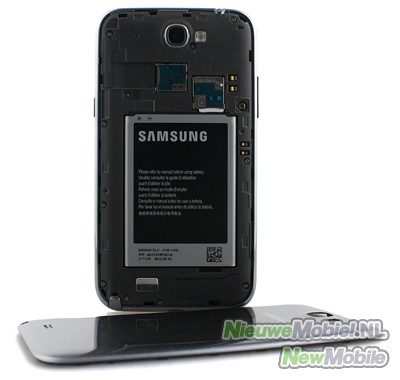
Although the device's energy used can't be called very thrifty, you can quite easily use this device for a day and a half, when you've loaded it up once. On top of that, Samsung offers you some battery saving options.
Call quality
Because the Note II is almost just as large as a regular house phone, the microphone is always close to your mouth when calling. Our conversations partners didn't have any complaints about the sound quality. The speaker can be turned on very loudly, but the highest sound level gives a bit of a distortion quite often. The speaker on the backside can be turned on very loudly as well, and it gives a surprisingly good call quality, even on the highest volume.
Display
The display isn't all unimportant for a fulltouch smartphone, but in the case of the Note II it's worth two times the trouble to take a close look at it. Diagonally, the display measures up to 5.5 inch, and it has a resolution of 1280 x 720 pixels. That's slightly less than its predecessor, but that hardly can be observed with the naked eye.
In spite of the display's proportions, hardly more information or interface is visible than usually on an Android device with a smaller screen. All of it is simply displayed bigger. Sometimes, this comes in handy, but we would like to put some more pictograms or widgets on it, for example on the home screens. Anyway, you can enlarge or reduce the font size.
A much-heard complaint about the Super AMOLED displays used to be their color rendering: that was often much too bright and unrealistic. To avoid this, Samsung made up the possibility to choose between different screen modes. You can choose between dynamic, standard, natural or film. Another problem with Super AMOLED is the fact that white doesn't really turn out white, due to a blue-green film. The Note II struggles with that as well. Only if you put the display's clarity at a 100 percent, this seems to disappear.
A fun new feature that Samsung adds to its devices is ‘smart fogging'. This means that the camera at the front detects whether you are looking at the screen and as long as that's the case, the standby mode won't be activated. This doesn't work entirely perfectly just yet, but it's a nice add-on. Especially on a device with a display as large as this one, on which you can easily read a large piece of text.
Menu
As we've said before, we started our testing with a firware update. The device had already been equipped with Android 4.1 Jelly Bean and Touchwiz interface, but Samsung deemed it necessary to add a few extra functions.
But let's start with the lockscreen. The user can put five self-chosen app links on this. The device in unlocked by sweeping over the display randomly.
The homescreen's applications can at this point be expected to speak for themselves. You have a maximum of seven of these at your disposal and thanks to Jelly Bean the widgets' size can be adjusted as well. The functionality of the notification bar deserves some extra attention. Samsung has added some functionalities to the Note II and Jelly Bean enhanced the options as well.
The most important add-on that was introduced by the firmware update, is the option to multitask splitscreen in two different apps. In order to activate this, you keep the return button pushed in for a short time, and then a dock appears on the left side of the display. The apps that are in this dock are the only ones that can be used for this functionality. You can open an app by sweeping it from the dock onto the display.
As a consequence of many lawsuits and complaints by Apple, and some other factors, Samsung was forced to adapt its ‘shell' on Android and in our view, this is merely a positive thing. Because Android regularly looks better and better, the producers' adaptations have to be less radical. The widgets that Samsung adds itself are still a bit disappointing. They mostly look ponderous and childish.
Phonebook
At first sight, the list of contacts is no more than just a list. But when you sweep from left to right over a name, this person is called immediately. A sweep to the other side will open the text message screen. In linking the different data of the same contact Samsung still lacks sometimes. It is indeed possible, but you will have to do it manually for a large part. Furthermore, Samsung has a list in which you can put your blocked contacts.
Messaging
Apart from the excellent standard Gmail app, there's another Samsung app for e-mail. This can work with almost every kind of mail account and you can synchronize multiple accounts with it. Messages from all this accounts can be displayed in one screen. When you hold the device horizontally, you can use this app in splitscreen.
Samsung installs ChatON on all its devices nowadays. This is a copy of Whatsapp, but it has a lot less users.
Typing with the device in the vertical mode is very easy and fast, especially when you're using two hands. The QWERTY keyboard has enough space to offer and above the letters you'll find an extra row for the numbers. The spelling check works properly as well.
Because Samsung gets that users often want to type with one hand on their phone and the displays of the Note II is actually too big for that, they added an extra possibility for one-handed operations. This means that the QWERTY keyboard and the numerical keyboard are made smaller and placed on the right or on the left side of the display.
Connectivity
Apart from the standard and widely known connectivity modes, the Note II also disposes of LTE and NFC. These are respectively a new quick mobile internet technology and a way to wirelessly exchange data. Unfortunately, these two new technologies still have a very limited applicability. With S Beam, you can wirelessly exchange other devices that support this as well. In practice, this means other Samsung phones.
Although Crome for Android is disposable by now, Samsung chose to use the standard browser and to extend this itself. Its functionality is for the largest the part the same as that of Chrome. Samsung did add a few buttons in the address bar. Extra functionalities can be used through the desktop. The browser is nice and quick, and thanks to the big display even desktop pages can be used perfectly.
The scrolling sometimes shows some catches. The pages are not automatically rescaled after zooming. This a functionality that you'll have to turn on yourself, somewhere deep in the settings menu. The newest Android phones don't support Flash anymore.
Camera
The camera at the backside of the Note II is an 8 megapixel camera with a single LED flash. Despite the fact that the interface may not be set up very cleverly, this camera work alright and it has the most important functionalities. The camera starts up very quickly and especially the HDR-function does a fine job.
In the search screen you can adept the flash, the photo settings and the effects. For more extended options you'll have to turn to the settings menu, where you can adjust the continuous shooting, scene mode, lighting, focus, timer, resolution, white balance, ISO, measurement, outside visibility, automatic contrast, directions, automatic sharing, anti-shaking, GPS tag and image quality.
The quality of the pictures is very high under good light, and in darker surroundings the very bright flash will help you out. The details are very clearly visible and the pictures aren't gritty at all. The colors might be a bit too bright, but that won't bother you at all.
The video camera can record with a maximum resolution of 1920 x 1080 pixels. The available settings are: the flash, video option, effects, lightning, timer, resolutions, white balance, outside visibility, directions, anti-shaking, GPS tag and quality.
Available applications
The Note II comes with the following apps: Allshare Play, calculator, ChatON, Dropbox, e-mail, FM radio, Game hub, search, clock, my documents, mp3-player, Paper Artist, Readers Hub, S Note, S Suggest, S Voice, Samsung Apps, Samsung GO, voice recorder, Talk and video player.
The list with standardized applications on the Note II isn't overly long, but still there are some unnecessary apps on it. Phone producers just can't seem to figure this out. For them, this is a way to give a personal touch to an operating system that they can influence less and less. Game Hub, Readers Hub, S Suggest and Samsung Apps all have more or less the same function as Google Play Store.
Games
There are no pre-installed games on the Note II. You could download them from Game Hub but this doesn't register previous purchases from the Play Store and the user-friendliness is far from perfect.
Extra's
Even though Samsung tried very hard to integrate the S Pen's functionalities as much as possible in the standard settings, we would like to treat it separately since this is the feature that sets apart the Note II the most, next to the big display. Moreover, the Samsung has enhanced the functionality compared to the first Note. The stylus is a bit longer and thicker, which makes it easier to grip.
When the S Pen is pulled out of the device, an extra homescreen opens automatically. This screen shows the S Note widget and a few specific apps. Then almost the whole interface can be commanded with the stylus, even though it sometimes doesn't react entirely accurately, or you have to use a finger, and that is quite bothering. In some specific settings you can activate a specific action or a preview of content by holding the S Pen about a centimeter above the display. This may not be something you'll automatically find out without the users' manual.
The most obvious application is of course entering text while using the S Pen. This asks a bit of skill and the software sometimes had some trouble with our handwriting. We won't choose the Note II for making notes in class or drawing up minutes. Still, it is apt to shorter notes or drawings and cutting/copying from images from other media works fine after some practice.
Conclusion
Although Samsung doesn't seem to know it yet – or maybe they just don't want to know – the Galaxy Note II is in fact the perfect smartphone for the elderly.
The beautiful big display is an obvious plus point that may make you choose the Note II, but the question still remains whether the size of the device can please you. We have our doubts about it. In some applications the display's size may be a nuisance, while on other points it work out just fine. The standard applications of a mobile phone work nicely and on top of that you have the relatively long battery life, the good camera and the fast processor.
In order to make full use of the S Pen you need some time. You have to put in some time and effort, because you can't work out its functioning while only playing. This is the reason why this accessory hasn't been able to convince us – it probably isn't the main reason for the average consumer to purchase the Note II.
















































